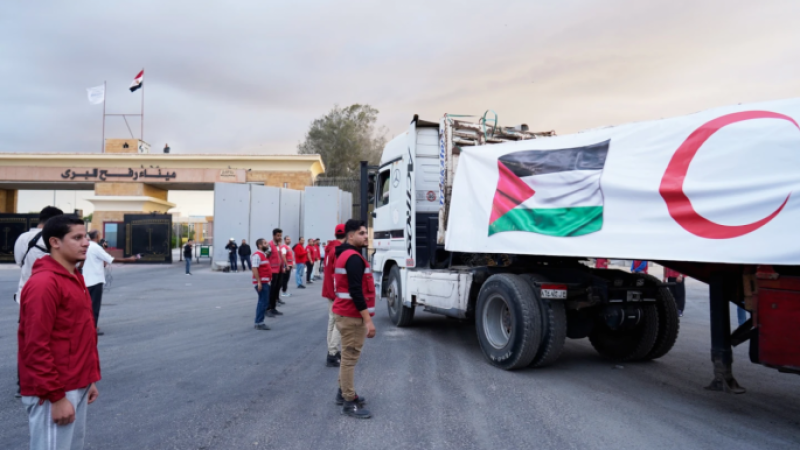- Khaleda now not fit for travelling: Medical Board |
- Panchagarh records lowest temperature 10.5°C so far this year |
- Christmas returns to Bethlehem after two years of Gaza war |
- কলাপাড়া মুক্ত দিবসে এবার সাড়া নেই কার |
- One killed, two injured in attack at Ctg meeting over marriage |
Aid ramps up in Gaza as ceasefire raises hope after war

Egyptian Red Crecent members monitor trucks carrying humanitarian aid as they enter the Rafah crossing between Egypt and the Gaza Strip, following an agreement between Israel and Hamas on a ceasefire, 12 October 2025.
Authorities in Gaza began preparing on 12 October to increase humanitarian aid following a new ceasefire deal, offering hope that the devastating two-year conflict may be easing.
Israel’s Coordinator of Government Activities in the Territories (COGAT) said daily aid deliveries are expected to rise to around 600 trucks under the agreement. Egypt plans to send 400 trucks on Sunday, all subject to inspection by Israeli forces before entering Gaza.
Footage from the Rafah crossing showed dozens of trucks carrying food, medical supplies, fuel, tents, and blankets. In recent months, only about 20% of needed aid reached Gaza due to fighting, border closures, and restrictions.
The prolonged blockade and military operations had triggered a severe hunger crisis, with famine reported in some areas. The UN has roughly 170,000 tonnes of food, medicine, and other supplies ready for entry once approvals are granted.
The future role of the Gaza Humanitarian Fund (GHF), a US and Israel-backed contractor that replaced UN operations as the main food distributor in May, remains uncertain. Several distribution points in Rafah, Khan Younis, and the Netzarim corridor were dismantled after the ceasefire, leaving many Palestinians without immediate access to aid.
Preparations are also underway for the release of hostages held in Gaza and Palestinian prisoners in Israel. Israel’s coordinator for hostages, Gal Hirsch, informed families that living hostages—estimated at 20 of 48—will begin to be released on Monday. Deceased hostages will be transferred to the Forensic Institute, while an international team searches for those not immediately recovered.
US President Donald Trump, who helped broker the ceasefire, is scheduled to visit Israel on Monday to meet hostages’ families and address the Knesset before traveling to Egypt to co-chair a regional peace summit with President Abdel-Fattah el-Sissi and other leaders.
Under the agreement, some 2,000 Palestinian prisoners, including 250 serving life sentences and 1,700 detained during the war, are expected to be released, though the timing has not been confirmed. Gaza health authorities are preparing for returning prisoners, many of whom require urgent medical attention, as well as the repatriation of bodies held by Israel. Officials have also requested the release of detained medical personnel.
As Palestinians returned to areas vacated by Israeli forces, many found their homes destroyed. Satellite imagery showed long lines of vehicles traveling north to Gaza City, while makeshift tents along the coastline provided temporary shelter. Hamas-run police patrolled the streets and escorted aid trucks to ensure security.
The conflict began on 7 October 2023, when Hamas launched a surprise attack on southern Israel, killing around 1,200 people and taking 250 hostages. Israel’s counteroffensive has since killed over 67,000 Palestinians, according to local health authorities, displacing roughly 90% of Gaza’s two million residents and leaving large areas in ruins.
While the ceasefire and planned prisoner and hostage releases have been welcomed by both sides, its long-term stability remains uncertain. Key issues, including Gaza’s governance and Hamas’ future, are yet to be resolved. Israeli Defense Minister Israel Katz said the military is prepared to dismantle Hamas’ tunnel network in Gaza under US-supervised international mechanisms once hostages are released.

